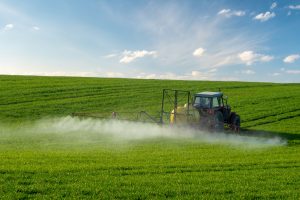
Tractor spraying pesticides
If we can understand how pesticides cause water pollution, we can adopt the required management practices to prevent this type of pollution from occurring in the first place. Here’s a short ‘ABC guide’ to help understand water pollution caused by pesticides. With thanks to Chris Peacock from Aquaread:
What are pesticides?
Pesticides are substances designed to kill any unwanted pests that could interrupt or damage the growth of a crop. Unfortunately, pesticides do not choose what to kill or harm, once they are sprayed, they are at the mercy of nature. Wherever they end up, they cause further harm, irrespective of their original purpose.
How do pesticides & fertilisers cause water pollution?
Pesticides can make their way into water sources in many ways. Spraying pesticides near to a water source is a surefire way to cause pollution. Some more indirect causes include:
- Agricultural runoff due to rain, irrigation, or melted snow/ice
- Overflow of irrigation return flows (where water from irrigation is returned to be used again)
- The manufacturing of pesticides themselves
- Spraying down crop collection boxes when empty
- Equipment malfunction or leaking storage boxes
If soil is compacted by heavy machinery, this too can impact the amount of pollutant-filled runoff entering waterways. Once in our waterways, the pollutants can enter ponds, lakes, rivers and oceans and even our drinking water sources, if not properly managed. Scary!
The effects of pesticides in water:
Pesticides can have toxic effects and even be fatal to plants, insects and wildlife in water bodies. Disrupting or killing one species in a water body, puts the entire ecosystem at risk. For example, if a bird eats a contaminated fish, they too can become sick or die. Put simply, pesticides in water can be an environment killer and extremely harmful to water dwelling species.
As part of the same local ecosystem, humans can find their drinking water sources are also contaminated. This is why there are strict regulations and multiple permit and license requirements, particularly for pest control operators and agricultural users of pesticides.
Can we prevent pesticide pollution?
Onto the positives! There are countless ways to reduce the harm of pesticides. First and foremost, avoiding pesticide use altogether is a good idea, particularly in the home environment. On an agricultural level, farms have introduced practices such as crop rotation, sowing resistant crop varieties to reduce pesticide reliance and establishing “buffer strips” by not spraying close to water. Ploughing, cleaning tillage equipment, effective management of manure and infected plants are other ways that help disrupt the environments that pests can thrive in, in turn reducing the need for chemicals in the first place.
How can you test for pesticides in water?
As the chemicals used in pesticides vary so much, the tests needed to check for them in water differ. The different parameters that offer clues that water may be contaminated include:
- pH levels (may be lowered)

- CO2 (may be increased)
- Chloride (may be increased)
With efforts to reduce pesticide usage and effective continuous testing, our waters can stay clean and healthy!
HydroTerra has a comprehensive range of Aquaread sensors enabling better water quality management. Check out the range here. Here’s the link to the full Aquaread article by Chris Peacock: The Impacts of Pesticides On Water Quality – Aquaread





